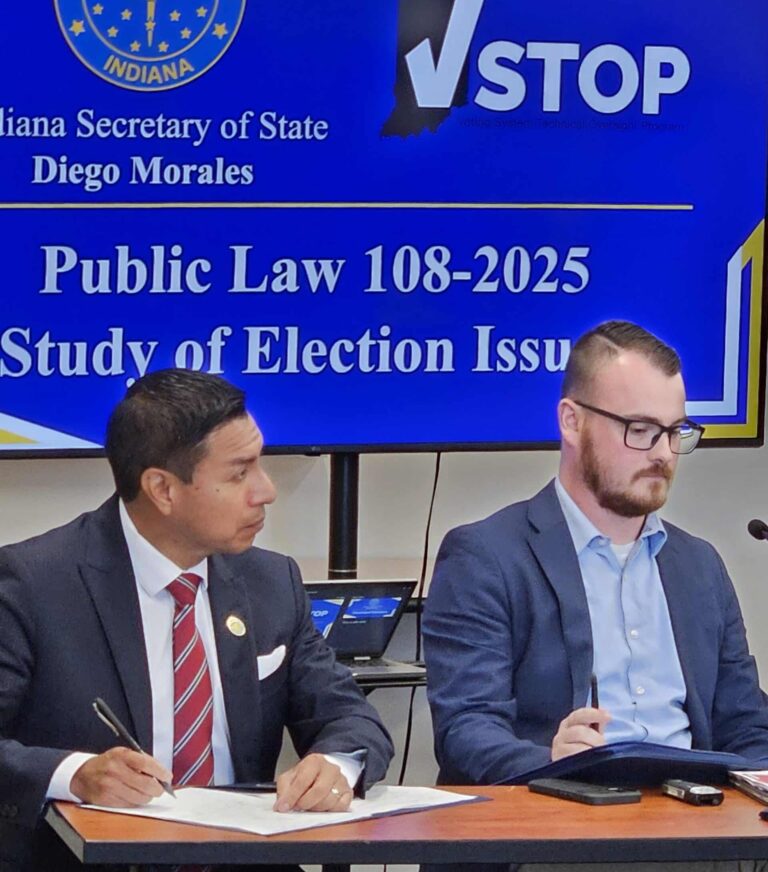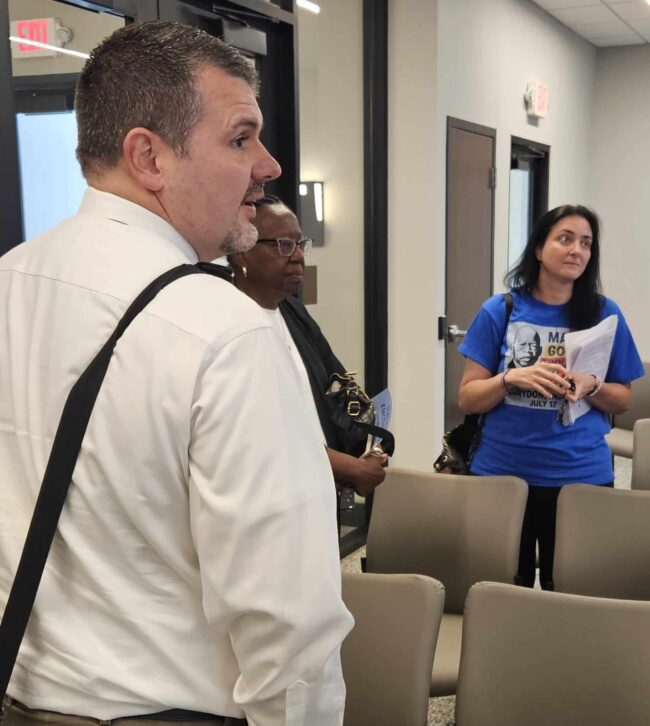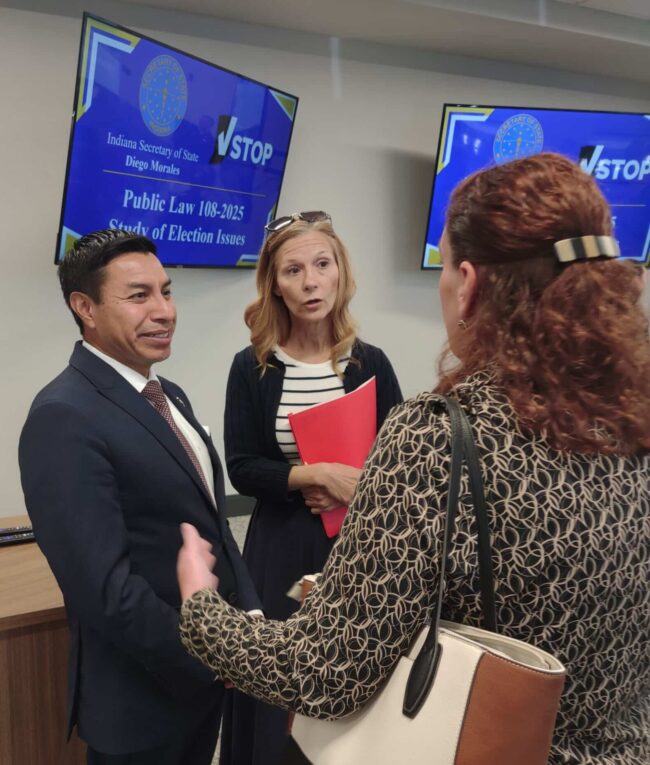
By Marilyn Odendahl
The Indiana Citizen
November 21, 2025
In its study of elections, Indiana Secretary of State Diego Morales’ office found administrative costs and voter turnout are most impacted by the timing of municipal contests, while the location of where the ballots are cast, whether at a voting center or polling place, made only a marginal difference.
The study, mandated by House Enrolled Act 1633, was conducted from August into October and included five public meetings held across the state to present data and gather feedback from attendees. At each meeting, officials from the secretary of state’s office and the Voting System Technical Oversight Program (VSTOP) at Ball State University detailed their research and took questions from the audience.
Specifically, the analysis focused on the impact on costs and voter turnout if the municipal elections were conducted during the odd-numbered years immediately preceding the years of presidential contests or moved to even-numbered years to coincide with either the mid-term or presidential elections. Also, the review looked at the effect on costs and turnout of requiring all counties to use fewer, larger vote centers, rather than polling places in the individual precincts.
In general, the study found municipal elections cost about the same to administer as mid-term elections, but attract significantly fewer voters, so the cost per vote in local contests is much higher than in mid-term and presidential elections. Consequently, the report indicates money could be saved by moving municipal elections to even-numbered years. Also, it said the number of ballots cast in local races would likely increase.
The examination of voting centers noted a cost savings because they are more efficient and require fewer poll workers to help voters compared with the number of workers needed at polling places. Conversely, vote centers did not appear to boost voter turnout and provided little difference in voter experience compared with precinct polling places.
The secretary of state’s office was required to submit its report to the legislature before Nov. 1. This week, it released the 95-page study to the public.
The report did not include any policy recommendations.
“We weren’t required to publish this study online, but my office continues to go above and beyond to keep Hoosiers informed,” Morales said in a press release. “Transparency is one of our top priorities.”
The secretary of state’s election study was born out of an attempt in the state legislature during the 2025 session to move most municipal elections to even-numbered years. However, the effort was muted and lawmakers decided instead to have Morales conduct a study.
As required by HEA 1633, the secretary of state’s office scheduled three public meetings in Muncie, Indianapolis and Jeffersonville. Then, to get more feedback from Hoosiers, two additional meetings were scheduled in Evansville and Munster and a special email address was created to take comments on these voting issues.
Public comments and reaction were included in the secretary’s final report.

A majority of the respondents were against moving municipal elections and were opposed to the state mandating that counties use vote centers, according to the report.
Many people were concerned that in shifting all elections to even-numbered years, local candidates and local issues would be overshadowed by the national races for Congress and the White House. However, some supported changing the timing of local contests because of the cost savings and increased voter participation.
Also, most respondents said the decision about using vote centers should be left to local communities. Their concerns included not being able to get to the vote center locations and the perception that polling places make elections more secure. The report noted residents of Lake County who provided feedback were unanimously opposed to voter centers over fears that because their community lacked public transportation, many seniors would not be able to get to the centralized polling places and cast their ballots.
Local election administrators, on the other hand, were more supportive of syncing municipal elections with mid-term and presidential contests. However, many said local municipalities should be able to make their own decision about the timing of local races. Similarly, they wanted to retain local control over whether to adopt vote centers.
What the legislature will do with this report is unknown. The committee assignments recently released from the Indiana Senate again list Rep. Mike Gaskill, R-Pendleton, as the chair and Sen J.D. Ford, D-Indianapolis, as the ranking minority member.
In his press release, Morales did not indicate whether he will be talking to legislators about the report or pushing for changes based on the findings and feedback.
“By making this report available, it’s evident how hard our team is working to strengthen elections and serve every Hoosier with integrity,” Morales said in his news release.
The study was divided into two parts with the secretary of state’s office examining municipal election timing and Ball State’s VSTOP team doing the analysis of vote centers.

Reviewing data from the 2018 through 2024 election cycles, the secretary of state’s office found presidential elections were the most expensive to administer, approaching $30 million. Comparatively, mid-term and municipal elections cost just about over half that in the $16 million to $19 million range.
Yet, the cost per vote is significantly higher in local elections because the turnout is substantially lower.
Less than 25% of registered voters in Indiana participated in the 2019 and 2023 municipal general elections compared with the more than 60% who participated in the 2020 and 2024 presidential general elections. The turnout for the mid-term general elections varied from 50.7% in 2018 to 39.6% in 2022.
Consequently, the cost per vote in the 2022 mid-terms and the 2024 presidential general elections was $5.26 and $5.47, respectively. Conversely, the per vote cost in the 2023 municipal general election was nearly three times higher at $15.62.
The secretary of state’s office concluded that if municipal elections were moved, the higher voter turnout in the presidential and mid-term elections would result in more voters casting ballots in local races. Even if some voters become fatigued while filling out their ballots and do not vote in the down-ballot contests, which would likely include the municipal candidates, the increased turnout would overcome the drop-off and still bring in more votes.
The drop-off rate, the report noted, increased in relation to the number of uncontested, down-ballot races.
Examining data from the 2016 through the 2024 elections, VSTOP found vote center counties used 22% and 19% fewer poll workers in the 2022 mid-term and the 2024 presidential general elections, respectively, than the precinct-based counties.
Relatedly, costs decreased. VSTOP reported vote center counties spent $15,912 on poll worker pay compared to $28,325 in counties that used precinct polling places. Also, while the cost-per-voter declined overall, the gap between vote center counties and precinct counties widened to where counties with vote centers saved on average $1.48 per voter across six election cycles ending in 2024.
Precinct-based counties showed slightly higher voter turnout rates than vote center counties, but that gap has narrowed as the number of counties switching to vote centers has increased over time. Also, reviewing survey data from other studies, VSTOP found the experience, including voter wait times and ease of voting, varied little between vote centers and polling places.
Dwight Adams, an editor and writer based in Indianapolis, edited this article. He is a former content editor, copy editor and digital producer at The Indianapolis Star and IndyStar.com, and worked as a planner for other newspapers, including the Louisville Courier Journal.
The Indiana Citizen is a nonpartisan, nonprofit platform dedicated to increasing the number of informed and engaged Hoosier citizens. We are operated by the Indiana Citizen Education Foundation, Inc., a 501(c)(3) public charity. For questions about the story, contact Marilyn Odendahl at marilyn.odendahl@indianacitizen.org.